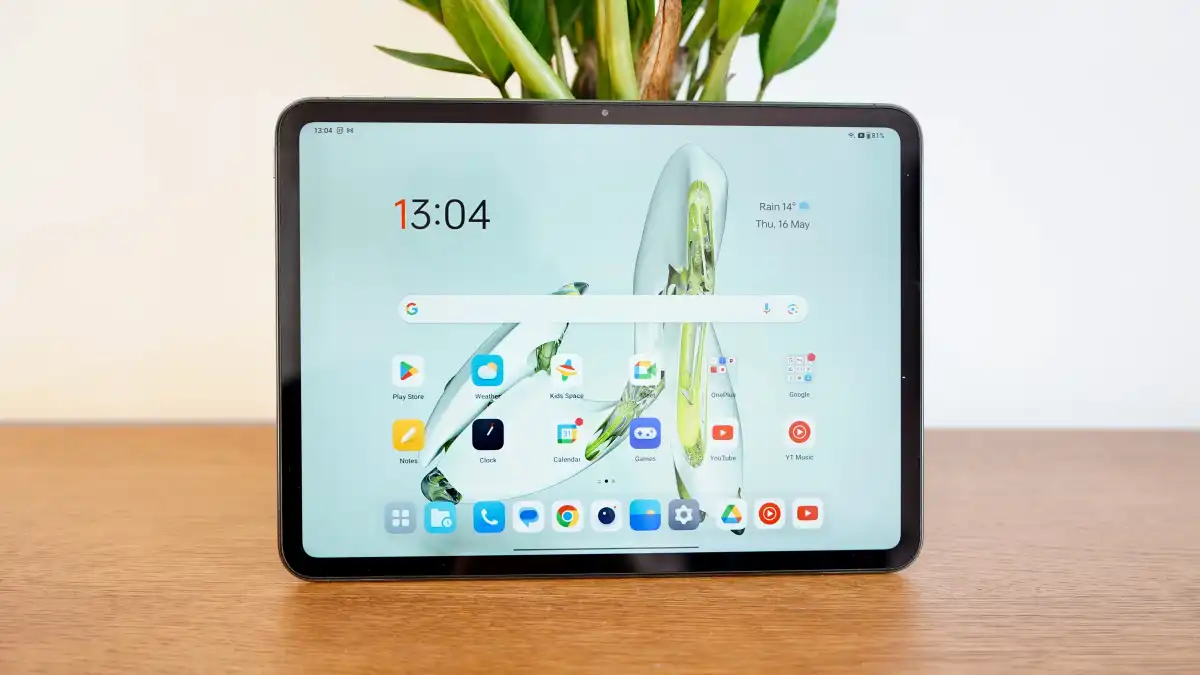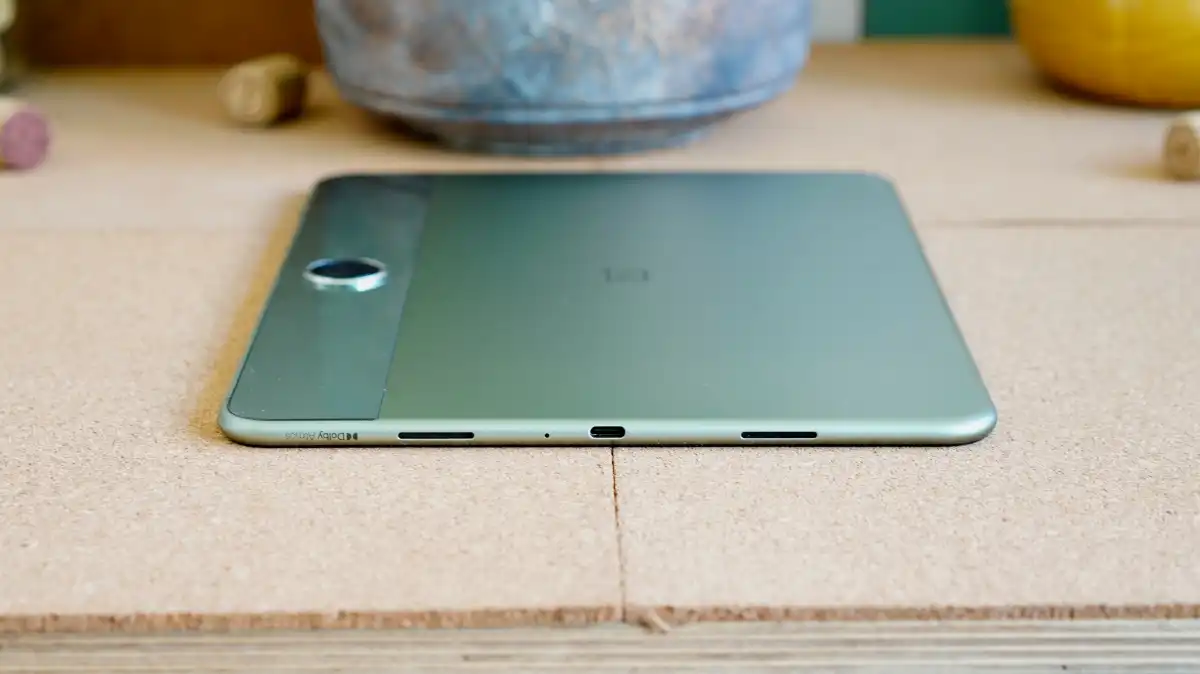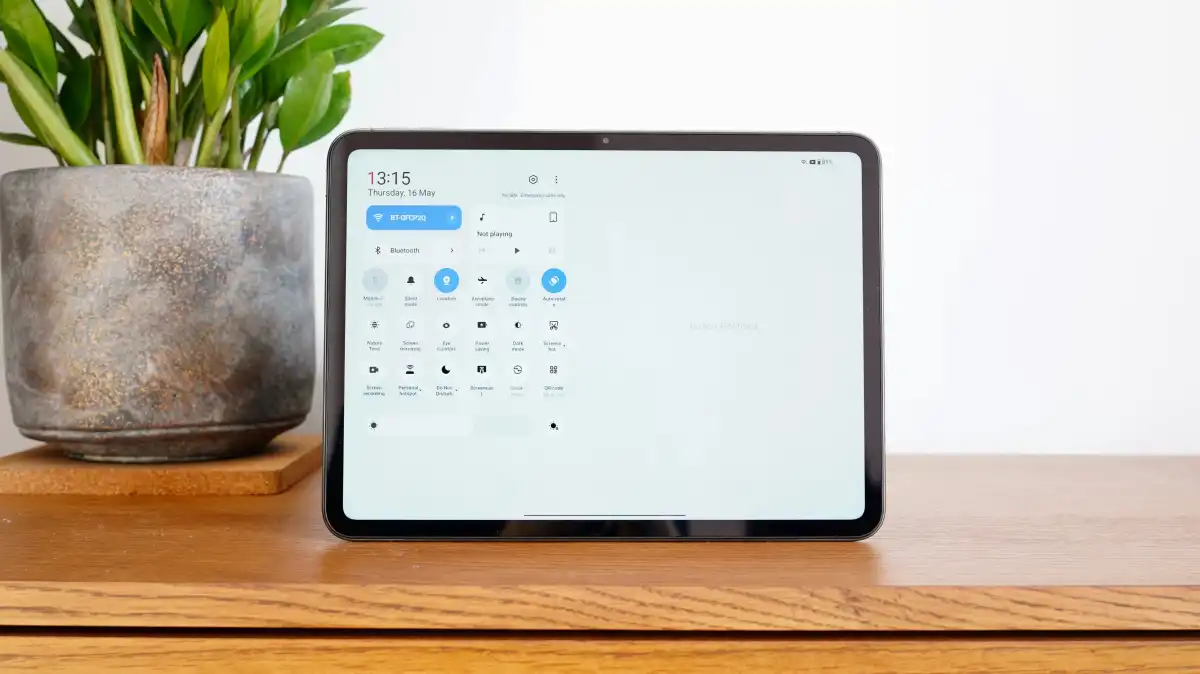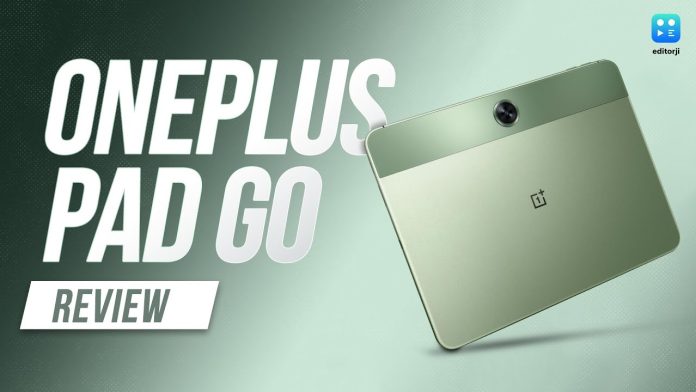Less than a year after the OnePlus Pad, which introduced the brand to the competitive world of Android tablets, the ‘Never Settle’ company is back with the OnePlus Pad Go.
Interestingly, this isn’t a direct sequel to the first Pad, and it doesn’t appear to be attempting to accomplish anything much different than the OnePlus Pad. Rather, the OnePlus Pad Go aims to offer something similar at a lower cost.
It’s another full-sized media tablet, but this one makes careful concessions to fundamental components to keep the price around £300.
Design & Build
- Aluminium and plastic build
- Only available in ‘Twin Mint’
- No fingerprint sensor, just insecure face unlock
For the Pad Go, OnePlus has used a design language similar to that of the OnePlus Pad. This is another sage-green (‘Twin Mint’) tablet with rounded corners and an overly large camera module in the center.
It’s a nice-looking piece of gear, if not as premium-feeling as its bigger brother. The Go now features a split between a classic aluminum frame and a slick plastic strip along the top, where the camera is located.

The latter appears great until you contact it with your fingertips, at which time it transforms into a greasy nightmare. Why do manufacturers do this, I wonder?
It weighs 532g, which is significantly lighter than the OnePlus Pad, but it’s still not exactly light – especially given that its 11.35in display is slightly smaller. It’s slightly thicker at 6.9mm.
The OnePlus Pad Go comes up to its name and outperforms the more expensive Pad by featuring a SIM tray on its left edge. This means you can access the internet while out and about by just inserting a SIM card.

What you don’t get is the OnePlus Pad’s pogo connector, so there is no keyboard cover option this time. There is no 3.5mm headphone jack, only a standard USB-C port on the right edge.
Given that the original Pad did not include a fingerprint sensor, it should come as no surprise that the Pad Go does not either. However, the alternatives – an unsecure face unlock or a time-consuming pin code method – are equally undesirable.
Screen & Speakers
- 11.35in LCD display
- 90Hz refresh rate
- Solid quad stereo speakers
The Pad Go’s display is somewhat smaller and less glossy, but it’s still a good attempt from OnePlus.
You get an 11.35-inch 2408 x 1720 IPS LCD panel with the same unique 7:5 aspect ratio as before. It feels more suited to a wider selection of material than your typical widescreen Android tablet, which means the tablet feels much more natural and functional in portrait position.
The Pad Go’s display isn’t as brilliant as the original Pad’s, with a maximum brightness of 400 nits (vs 500 nits). Using a colorimeter, I measured it at 382 nits with autobrightness turned off, which is approximately 100 nits lower than our OnePlus Pad reading.

It’s also nowhere near as smooth as its bigger brother, with a refresh rate of 90Hz, which falls well short of the Pad’s 144Hz. The latter has always felt like overkill, especially in a less-than-Pro tablet, yet the Pad Go is quite smooth enough in ordinary use.
It’s worth mentioning that this is the maximum screen refresh rate option for the OnePlus Pad Pro, and the optimum refresh rate for the work will be selected automatically. You can’t force this, but you can set it to 60Hz if battery life is a necessity.
This is also a reasonably color-accurate display, especially when you switch from the default Vivid mode to Natural. True to its name, it reduces the additional pop and makes things appear more, well, natural.
Audio output is handled by a healthy set of four speakers

OnePlus emphasizes the Pad Go’s eye care capabilities, with adaptive brightness and Low Blue Light technology promising to alleviate eye strain. Given its posture as a tablet for curling up in a darkened room and watching a movie, it’s a wise (though far from unique) addition.
The audio output is handled by a healthy set of four speakers, two on each edge when held in landscape mode. With Dolby Atmos support, high-quality movie material from platforms such as Disney+ sounds great – loud, clear, and spacious, albeit not the greatest in terms of bass.
Specs & Performance
- Mediatek Helio G99 chip
- 8GB LPDDR4X RAM
- Adequate performance
OnePlus has reduced performance for the Pad Go by upgrading to a somewhat basic (and old) Mediatek Helio G99 processor.
This is the same processor found in the Poco M5, a cheap smartphone released a few years ago. More recently, Acer used this processor in the Iconia P11, a £249 Android tablet.
As the name implies, it’s not a particularly spectacular performer, falling far short of the Xiaomi Pad 6 with its Snapdragon 870 and the Google Pixel Tablet with Tensor G2 in benchmark tests. Naturally, it is significantly slower than the OnePlus Pad, which has a MediaTek Dimensity 9000 processor.
It’s got enough power to run most applications adequately

There’s no escaping the limited performance in use, which includes minor halts and stutters when switching between home screens and delays when launching apps. It’s not too serious, though, and the 8GB of RAM prevents it from being a major issue.
Ideally, the OnePlus Pad Go should be considered as a single-purpose media tablet. It has enough power to run most applications adequately, and you can even run lighter apps side by side without sacrificing performance, but you shouldn’t count on it for heavy multitasking.
Similarly, while it can handle simple games like Slay the Spire well, more complicated 3D titles like Wreckfest would require you to reduce the graphical settings to medium or low if you want them to function smoothly.
The standard storage capacity is 128GB. There is a 256GB model available in several locations, but not in the UK. There is also a dedicated microSD card slot in case you need to expand it further.
OnePlus Pad Go benchmarks
Cameras
I should only mention the camera setup briefly here because such features are rarely a priority in a tablet, let alone a cheap one. On the back, there is an 8MP sensor that exactly fits the term ‘bog standard’.
Even in decent daylight lighting, photos shot with this camera show a significant lack of clarity and pop, with noticeable graininess in blue skies and a low dynamic range. The 8MP front camera is similarly poor, unable to highlight things.
Of course, none of this is shocking, and similar statements can be made about almost any low-cost tablet available. I don’t expect decent photography capabilities from such devices, therefore I’ll move on.



Battery Life & Charging
- 8000mAh battery
- Multiple days of light usage
- 33W charger not included
The OnePlus Pad Go has a relatively tiny 8000mAh battery. It’s undoubtedly much smaller than the OnePlus Pad’s 9510mAh battery.
It generally lasts days and days on standby

Indeed, the Go performed far worse than its brother in our standard PCMark Work 3.0 Battery test, falling nearly three hours short at seven hours and 57 minutes.
In practice, however, I have a few complaints. The tablet was still running after two and a half days of light to moderate use, with a total of five hours and 20 minutes of screen time – albeit with only 7% battery life remaining. It typically lasts many days on standby, which is ideal for a casual tablet like this.
The charging capability is not as remarkable as the complete OnePlus Pad, maxing out at 33W. In addition, there is no charger included in the box.
You’ll need to be precise about the charger you use. Using a 33W Xiaomi charger, it only reached 10% from empty in 15 minutes and 21% in 30 minutes. Hooking up the OnePlus 12R’s 100W charger, however, increased it to 19% and 34%, respectively.
Software & Apps
- OxygenOS 13.2 on Android 13
- Tablet-specific features work well
- Lack of capable, optimised apps
If there is one area where it is comparable to the OnePlus Pad, it is in software. You receive the same proprietary OxygenOS 13.2 UI placed over Android 13.
Yes, that is Android 13, not the current Android 14, which has been out since October 2023.

Still, OnePlus’ tablet software is quite impressive. The OS isn’t the most visually appealing, given it’s built on Oppo’s busy ColorOS, but it’s really practical.
You can run two apps simultaneously, one as a floating window (with the previously noted performance limits). There is also a side menu that can be reached by sliding in from the top right edge, providing rapid access to recently used files and apps.
Swiping left brings you to Google’s always-useful Discover feed, where you’ll find relevant news headlines and articles, as well as media recommendations from your preferred streaming applications.

None of this is very new, but it does not have to be. If you want to be more productive, keep in mind that Android still lags behind iPadOS in terms of adequately tablet-optimized apps, and the OnePlus Pad Go isn’t strong enough to handle complicated work.
Another drawback is that upgrades will only be available for two years. Given that one of options will most likely be a tardy move to Android 14, there is little chance for long-term support.
Price & Availability
The OnePlus Pad Go is available now in a single 128GB configuration with an RRP of £299.
At the time of writing, OnePlus was selling it at a discounted price of £269 directly from its website. Amazon was also selling it at the same price.
Specs
- Android 13 with OxygenOS 13.2
- 11.35in, 2408 x 1720, IPS LCD, 90Hz display
- Mediatek Helio G99
- 8GB LPDDR4X RAM
- 128GB/256GB storage
- 8Mp main camera
- Up to 1080p @ 30fps rear video
- 8Mp front-facing camera
- Dolby Atmos Quad Speakers
- SIM slot
- Wi-Fi 802.11 a/b/g/n/ac
- Bluetooth 5.2
- 8000mAh battery
- 33W charging
- 255.1 x 188 x 6.9mm
- 532g
- Launch colours: Twin Mint


